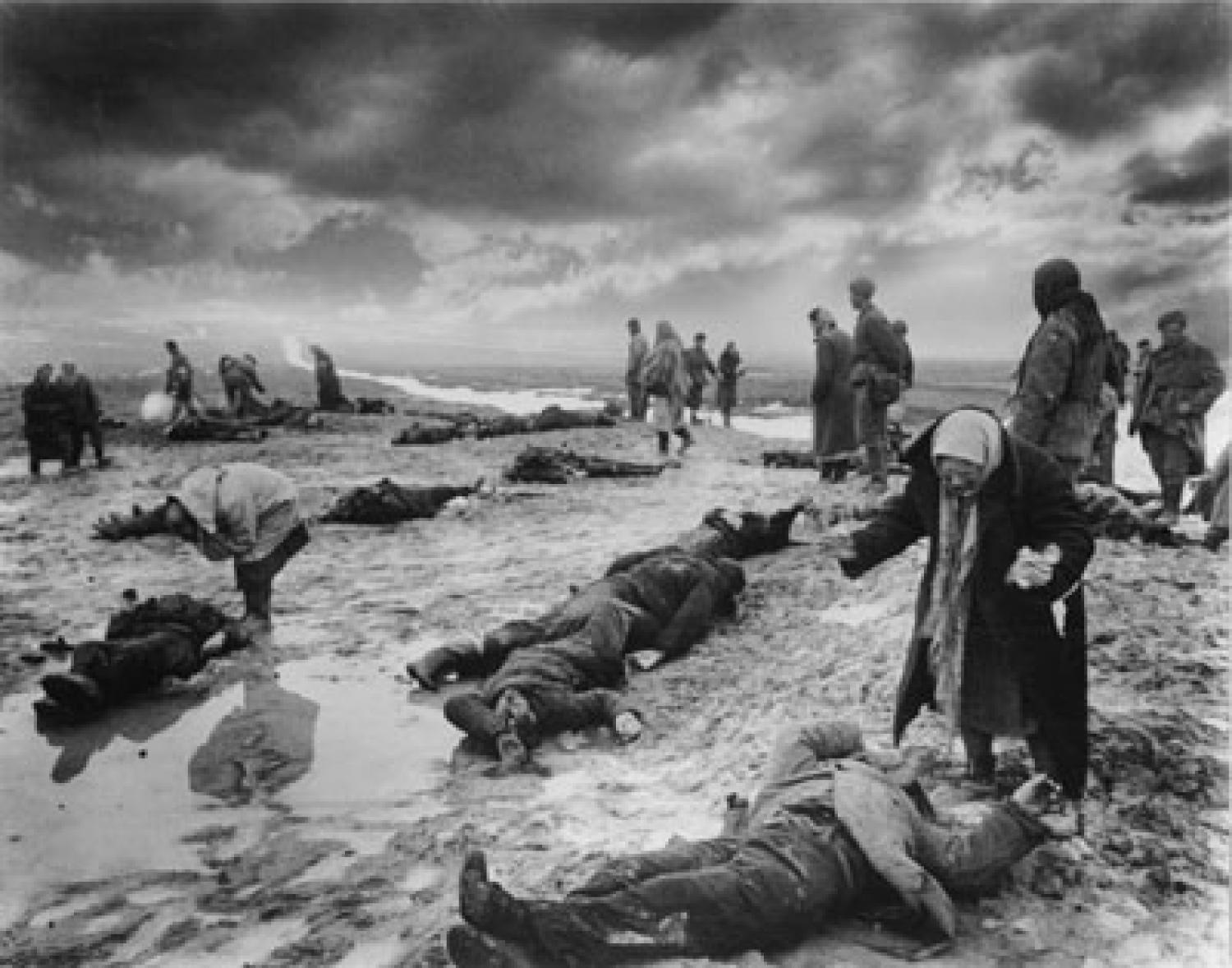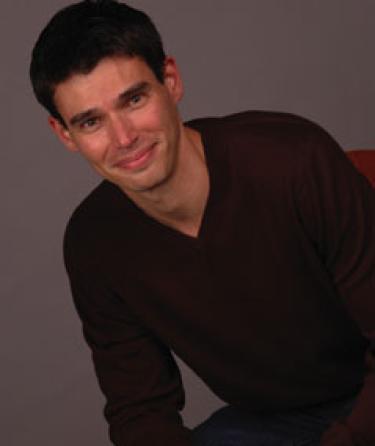
Soviet photographers recorded Nazi atrocities, but state’s message changed after Stalin and after Soviet Union’s collapse; CU professor notes the significance of overlapping narratives and memories
Soviet photojournalists working for the country’s most important newspapers were among the first to document the unfolding Holocaust in their homeland, and they were also witnessing and recording the slaughter of Soviet citizens who, like the photographers themselves, were Jewish.
But the extent to which the Nazis targeted Jews was obscured in the dominant Soviet press during World War II and was suppressed in the Cold War era, during which the Soviets dwelled on the depravity of “fascist troops” murdering “peaceful Soviet citizens.”
The Soviet Union’s collapse allowed scholars to see a fuller picture of what happened, and to understand the overlapping narratives of Soviets and Jews.
 David Shneer, associate professor of history and director of the Program in Jewish Studies at the University of Colorado, began researching this issue in 2002, when he visited a photography gallery in Moscow.
David Shneer, associate professor of history and director of the Program in Jewish Studies at the University of Colorado, began researching this issue in 2002, when he visited a photography gallery in Moscow.
The exhibition was titled “Women at War,” and Shneer noticed that the photographers’ names sounded Jewish. He asked the curator, who said, “Of course they’re Jewish. All the photographers were Jewish.”
Before the war, many of those developing the profession of Soviet photojournalism were Jewish, Shneer notes.
The German Army invaded the Soviet Union in June 1941. Within days, the leading illustrated magazine, Ogonek (the Life magazine of the Soviet Union), published its first atrocity photo. That picture, retrieved from the camera of a dead German soldier, showed Nazis forcing Jewish victims to dig a grave for a pile of corpses.
As Shneer notes in the February issue of the American Historical Review and in his forthcoming book “Through Soviet Jewish Eyes,” the Soviet Army regularly urged its press to publish stories and photos of Nazi atrocities.
“This material would function as visual evidence of the Nazi crimes and as propaganda to rile up the anger of the population,” Shneer writes.
But the photo caption did not specify that the victims were Jewish. Instead, it said, “Those sentenced are forced to dig their own graves.”
During World War II, the Soviets saw an advantage in framing the Nazi assault as being against the entire nation, not just Jewish people. As Shneer observes, there was a rationale: “Do you think a bunch of Russian peasants wanted to go fight a war because of Jews?”
Professional Soviet photographers, who were Jewish, did not witness the mass-murders of Jews until late 1941. The first photographs of Nazi killing fields came after the Soviet liberation of the city of Kerch in southern Russia. The Germans occupied Kerch for about six weeks before being driven out by the Red Army.
While in Kerch, the Gestapo registered 7,500 Jews. In the first week of December, the Nazis moved the victims to an anti-tank ditch on the outskirts of town and murdered them.
On Dec. 31, Kerch was one of the first Russian cities with a significant Jewish population to be liberated from Nazi occupation, “which meant that the city was one of the first places where Soviet soldiers, journalists and photographers saw what we now call the Holocaust with their own eyes.”
The sight was appalling.
In February 1942, Ogonek published photos of the carnage. One showed a barren, winter landscape strewn with bodies and lifeless except Soviet soldiers surveying the dead. Another photo showed a close-up view of some of the dead: a mother surrounded by children.
The photographer, Mark Redkin, was Jewish.
As Shneer notes, the photograph’s caption said Hitler’s “bandits” and “thugs” were ordered to “annihilate the peaceful Soviet population.” The Nazis were called Hitlerites or Germans, but the victims’ ethnic identity was obscured. “No mention is made of the fact that most of the dead women and children so grotesquely splashed across the pages of the magazine were Jewish women and children.”
A month later, Ogonek published two pages of photos taken by Dmitrii Baltermants and Israel Ozerskii along with an article. Though all of the journalists were Jewish, they, too, obscured the primary target of the Nazis, writing that the “German occupiers” killed 7,500 residents “indiscriminately—Russians and Tatars, Ukrainians and Jews.”
Still, the truth was discernable.

This 1942 photo of the Kerch atrocities carried this caption: “Kerch resident P.I. Ivanova found her husband, who was tortured by the fascist executioners.” Photo courtesy of Michael Mattis.
“Although this multi-ethnic marriage reflected the Soviets’ idealized notion that their diverse empire was a happy, integrated ‘brotherhood of nations,’ the fact could not have been lost on the reader that after the Nazis left town, the Ukrainian Tereshchenko was alive and the Jewish Kogan was dead.”
After the war’s end in 1945, the Soviets seldom discussed Nazi crimes because, as Shneer notes, the former “Hitlerites” and “bestial Germans” were now “liberated German people” who would be eventually become part of the Soviet constellation in East Germany.
Even as the Soviet press covered the Nuremburg Trials, the victims were again portrayed as peaceful Soviet citizens or as humanity itself. “Jews were included in both of those rubrics, of course, but only implicitly.”
“I like to point out that Jews were peaceful Soviet citizens,” Shneer says.
In the Yiddish-language Soviet press, which comprised two newspapers in the 1940s, a different “but equally Soviet story” unfolded, Shneer writes.
One of those newspapers, Unity, published an article headlined “Why Do the Fascists Hate the Jews So Much?” The Russian-language original was called “About Hatred” and did not mention Jews.
In the Yiddish press, photographs of Jewish burial sites and the Warsaw ghetto clearly noted that the victims were Jews. Shneer notes that while the Russian-language press stressed a national Soviet experience, “it was precisely the point of Unity to develop a specifically Jewish narrative of the Soviet war.”
Consistently in the wartime coverage of the Yiddish press, Shneer notes, journalists articulated a clear perpetrator (the Nazis) and a victim (Jews).
But the war’s end changed that. The Soviet press simply “stopped talking about war in general and Nazi atrocities in particular,” Shneer writes. Under Stalin, the war represented an unfortunate time—one best forgotten—during which 25 million to 30 million Soviets died.
In the 1960s, however, Soviet leaders strove to reinsert World War II into the nation’s memory. In 1963, a Czech publication called Praha-Moskva published a series of Baltermants photographs, including one of a grieving woman, P.I. Ivanova, whose husband was murdered by Nazis near Kerch.
When Ivanova’s photograph was published in Ogonek in 1942, the image was tightly cropped around the woman herself, and it was published with the intent to convey the enormity of the Nazis’ war crimes.
Two decades later, the photograph then titled “Grief” showed an expansive scene of suffering: scattered mourners around a wide landscape littered with corpses, all under a dark and menacing sky. Ivanova herself is shown leaning over her husband’s body, her arms plaintively open, her hands half-closed.
The photo was no longer about German atrocities, Shneer writes, adding that “it was now about the nature of evil and fostering a new national memory of the war.”
The caption on the 1965 photograph of the Kerch killing ground says that “fascist troops shot thousands of peaceful Soviet citizens, tossing their corpses into a nearby anti-tank trench.”
As Shneer notes, there is no mention of Germans, Hitler or Jews. “By 1965, Germans were liberated friends, not barbaric enemies, and the Great Patriotic War, as World War II was called in the Soviet Union, was figured as a battle of ideologies, not peoples, Soviets against fascists, not Germans against Jews, Russians and others.”
And while the photo came to serve a new purpose in the Soviet national memory, the photographer himself showed an altered memory. In published interviews in the ‘60s and later, Baltermants said “Grief” and other atrocity photographs “were never published during the war” (which was not true).
As Shneer suggests, Baltermants might have been downplaying the wartime history of his photographs and the mass-murder of Kerch’s Jews so as to “make this photo function as a visual icon in the Soviet war memory that emerged in the 1960s.” And by claiming to have been censored by Stalin, Baltermants might have been following the trend “toward universalizing the story of the Holocaust and toward highlighting his own oppression under Stalin.”
The collapse of the Soviet Union facilitated yet another shift in national memory—one that explicitly acknowledged the centrality of anti-Semitism in Nazi atrocities. That alteration was seen in the work of another wartime photographer, Evgenii Khaldei, whose most famous image is of the Soviet flag being raised over the Reichstag in Berlin in May 1945.

A photo by Evgenii Khaldeai showing a Jewish couple wearing stars as they were required to do in Nazi-occupied areas. Photo courtesy of Evgenii Khaldeii and the Fotosoyuz Agency
It did not appear again until after the Soviet Union’s collapse, whereupon it became famous. In the last seven years of his life, Khaldei was interviewed repeatedly about his work. In an interview with a Western writer, Khaldei recalled meeting the couple and telling them, in Yiddish, that he, too, was Jewish.
But when interviewed by a Russian journalist in the 1990s, Khaldei says he spoke to the couple in German and told them he was “Russian, Soviet.” In that interview, however, he does not use the word “Jew.”
In the 1990s, Shneer writes Khaldei “presented different selves and different frameworks for his photograph to audiences that 50 years later had very different memories of the war.”
Shneer emphasizes that his intent is not to impugn the photographers. As a historian, his interest is in determining what happened during the war, and to pose a question: How did the journalists’ position in the state lead to their position in forgetting?
Additionally, Shneer notes, his intent is to explore the relationship between individual and collective memory, which he says are inseparable.
“Returning iconic photographs to their original news context shows how photographs function in the creation of narratives and memories,” Shneer writes. “Soviet Jews, Baltermants and Khaldei among them, saw the war as many tragedies in one—personal, family, communal and national.”
When viewing these photographs in all of their historic complexity, he continues, “the distance between Soviet and Jewish, the war and the Holocaust, and Baltermants and Khaldei collapses.”
Shneer’s book “Through Soviet Jewish Eyes” will be published later this year. It can be pre-ordered through the publisher, Rutgers University Press.



